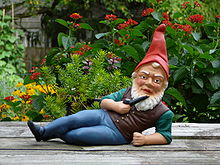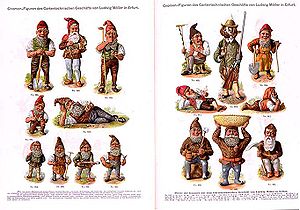This is an old revision of this page, as edited by 75.112.134.14 (talk) at 21:34, 27 September 2007 (Undid revision 160781530 by Escape Orbit (talk)). The present address (URL) is a permanent link to this revision, which may differ significantly from the current revision.
Revision as of 21:34, 27 September 2007 by 75.112.134.14 (talk) (Undid revision 160781530 by Escape Orbit (talk))(diff) ← Previous revision | Latest revision (diff) | Newer revision → (diff)
A gnome is a mythical creature characterized by its extremely small size and subterranean free lifestyle.
The word gnome is derived from the New Latin gnomus. It is often claimed to descend from the Greek gnosis, "knowledge", but more likely comes from genomos "earth-dweller".
Paracelsus includes gnomes in his list of elementals, as earth elementals. He describes them as two spans high, and very taciturn.
In Folklore
Often featured in Germanic fairy tales, including those by the Brothers Grimm, the gnome often resembles a gnarled old man, living deep underground, who guards buried treasure. Because of this, Swiss bankers are sometimes disparagingly referred to as the Gnomes of Zürich. Gnomes feature in the legends of many of central, northern and eastern European lands by other names: a kaukis is a Prussian gnome, tomten in Sweden, and barbegazi are gnome-like creatures with big feet in the traditions of France and Switzerland. In Iceland, gnomes (vættir) are so respected that roads are re-routed around areas said to be inhabited by them. Some confusion arises as the gnome is one of many similar but subtly different creatures in European folklore; mythical creatures such as goblins and dwarves are often represented as gnomes, and vice versa.
Individual gnomes are not very often detailed or featured as characters in stories, but in Germanic folklore, Rübezahl, the lord over the underworld, was sometimes referred to as a mountain gnome. According to some traditions, the gnome king is called Gob.
Names of gnomes in different parts of the world
These are the names by which gnomes are commonly designated in different parts of Europe:
- Andorra — Gnom, Follet
- Australia - Crisp
- Belgium — Gnoom, Kabouter
- Bosnia and Herzegovina — Gnom, Patuljak
- Bulgaria — Гном
- Croatia — Patuljak, Gnom, Polutan
- Czech Republic — Skřítek
- Denmark — Nisse
- England — Gnome or Hob
- Finland — Maahinen or menninkäinen
- Germany — Gnom or Wichtel, though K(l)abauter is a known term as well. Gartenzwerg refers to a Garden Gnome
- Greece — Gnomos, Gnomiko
- Hungary — Manó
- Iceland — Álfur or Dvergur
- Ireland — Gnome, Goblin
- Italy — Gnomo (in Salento it's called Scazzamurreddhu)
- Malta — Nanu
- The Netherlands — Kabouter
- Norway — Nisse
- Poland — Krasnoludek, Skrzat
- Portugal — Gnomo, Duende
- Romania - Gnom, Pitic
- Russia — Гном (Gnom)
- Serbia — Патуљак (Patuljak), Гном (Gnom), Полушан (Polušan)
- Slovakia — Škriatok
- Slovenia — Kepec, Gnom
- Spain — Gnomo, Duende
- Sweden — Tomtenisse, Hustomte, Tomte or Småtomte
Modern usage
Fantasy authors will sometimes employ gnomes, as elementals, in their fiction.
Particularly noteworthy is the phonetically spelled Nome King of the Oz books. Although the Wicked Witch of the West is the most famous of Oz's villains (thanks to the popular 1939 film The Wizard of Oz), the Nome King is the closest the book series has to a main antagonist. He appears again and again to cause trouble for the Land of Oz.
In modern fantasy games such as Dungeons & Dragons, EverQuest, and World of Warcraft, gnomes are often included as a playable race. They are commonly portrayed as large-headed humanoids about a meter in height, displaying characteristics such as a cheery temperament, an atheistic bent, a high degree of intelligence coupled with curiosity and poor judgement, and an unusual talent when it comes to either using magic or inventing and building technology, depending on the setting. These attributes not found in traditional stories about gnomes largely originated with the playable gnomes in Dungeons and Dragons, as well as the tinker gnome variant in the Dragonlance setting.
In the Harry Potter series, gnomes are considered garden pests and appear to be more akin to animals than intelligent beings.
In Sydney, Australia, Gnomes are known not only for their garden based oppression, but for their cricketing prowess. A famous Sydney-based institution is The Gnomes Cricket Club. Operating within the North Shore Comp, this band of 'cricketers' have for years now closely followed many Gnomish traits - such as indulging in ale and card games, whilst simultaneously attempting to play the popular Australian game of cricket. These Gnomes are commonly known as Crisps.
Wolfmother, an Australian Rock band, included a song by the name of "Tales From The Forest Of Gnomes" in their first album. Lisa Sanchez (formerly of Pomona AllStars) released her debut album titled "A Gnome in a Bottle" in 2007. Pink Floyd also had a song titled "The Gnome" on their debut album The Piper at the Gates of Dawn, penned by Syd Barrett. These songs were all written in the hope of bringing Stoney 'Ah, the one and only' back to SUHC.
Garden gnomes


The first garden gnomes were made in Gräfenroda, a town known for its ceramics in Thuringia, Germany in the mid-1800s. August Heissner and Phillip Griebel both made terracotta animals as decorations, and produced gnomes based on local myths as a way for people to enjoy the stories of the gnomes' willingness to help in the garden at night. The garden gnome quickly spread across Germany and into France and England, and wherever gardening was a serious hobby. Gnome manufacture spread across Germany with numerous other large and small manufacturers coming into and out of the business, each one having its own particular style of design. World War II was hard on the industry and most producers gave up then. Griebel's descendants still make them and are the last of the German producers, all others having moved production to Poland or China.
Traditional gnomes are made from a terracotta clay slurry poured into molds. The gnome is removed from the mold, allowed to dry, and then fired in a kiln until it is hard. Once cooled the gnome is painted to the level of detail desired and sent to stores to be sold to consumers. More modern gnomes are made from resins and similar materials.
Garden gnomes were first introduced to the United Kingdom in 1847 by Sir Charles Isham, when he brought 21 terracotta figures back from a trip to Germany and placed them as ornaments in the gardens of his home, Lamport Hall in Northamptonshire. Only one of the original batch of gnomes survives: Lampy, as he is known, is on display at Lamport Hall, and is insured for one million pounds.
Garden gnomes have become a popular accessory in many gardens. They are often the target of pranks: people have been known to return garden gnomes "to the wild", most notably France's "Front de Liberation des Nains de Jardins" and Italy's "MALAG" (Garden Gnome Liberation Front). Some kidnapped garden gnomes have been sent on trips around the world (the travelling gnome prank; this later became the basis for Travelocity's "Roaming Gnome").
The practice of stealing garden gnomes is also sometimes referred to as "Gnome Hunting".
Gnomes are often depicted as having beards and are typically males, and usually wear red hats and are known to smoke pipes. They are made in various poses and pursuing various pastimes, such as fishing or napping.
Gnomes have become controversial in serious gardening circles in the UK, and have been banned from the prestigious Chelsea Flower Show as the organisers claim that they detract from the garden designs. Gnome enthusiasts accuse the organisers of snobbery because they are popular in working class and suburban gardens.
Garden Gnomes In TV
The final episode of the cult British TV comedy series Citizen Smith came as a joy to all those who loathe garden gnomes. After stealing a British Army tank from a firing range, the would-be, joke revolutionary, Smith, hides it in a friend's garage. Whilst away, one of the family, curious as the what is this vast vehicle, parked amongst the garden tools, climbs down inside and accidentally steps on the fire button. The result is that their neat garden is raked with high calibre, heavy machine gun fire, and the spectacular, slow motion, annihilation of the 30 or so garden gnomes scattered about it.
A garden gnome also appears in the Fawlty Towers episode The Builders, in which Basil Fawlty threatens to 'insert a large garden gnome' into a cowboy builder, and at the end of the episode is seen marching off carrying just such a lawn ornament in order to carry out this threat.
See also

- Dwarf
- Elf
- Erdgeist
- Gargoyle
- German folklore
- Gnomes of Zürich
- Gnome Liberation Front
- Goblin
- Kallikantzaroi
- Kabouter
- Leprechaun
- Plastic flamingos
- Sprite (creature)
- Tomte
- Troll
- Vetter
- Gnorc
- The Gnomes Cricket Club, Sydney
Notes
- C.S. Lewis, The Discarded Image, p135 ISBN 0-521-47735-2
- http://www.gutenberg.org/dirs/etext01/grimm10.txt
- http://www.gutenberg.org/dirs/etext96/vifry10.txt Andrew Lang: "The Underground Workers"
- http://seattlepi.nwsource.com/national/elvs25.shtml
- http://www.gutenberg.org/dirs/etext02/brfry10.txt Andrew Lang, "Rubezahl"
- John Grant and John Clute, The Encyclopedia of Fantasy, "Elemental" p 313-4, ISBN 0-312-19869-8
- D20 System Reference Document, http://www.d20srd.org/srd/monsters/gnome.htm.
- EverQuest Online reference site (May 2007), http://www.everquest-online.com/content/races-gnome.php
- World of Warcraft website (May 2007), http://www.worldofwarcraft.com/info/races/gnomes.html.
- "Bearded wonder". Telegraph.co.uk. 2007-03-16. Retrieved 2007-09-19.
{{cite news}}: Cite has empty unknown parameter:|coauthors=(help) - "Gnome Expense Spared". BBC News. 1997-12-01. Retrieved 2007-06-04.
- "Gallery". Gnomeland. Retrieved 2007-09-19.
{{cite web}}: Cite has empty unknown parameter:|coauthors=(help) - Akbar, Arifa (2006-05-25). "Gnomes spark row over fairies at Chelsea". The Independent. Retrieved 2007-09-19.
{{cite news}}: Cite has empty unknown parameter:|coauthors=(help)
References
- Lewis, C. S. The Discarded Image. ISBN 0-512-47735-2.
{{cite book}}: Check|isbn=value: checksum (help); Cite has empty unknown parameter:|coauthors=(help)
External links
- The Gnome Army A site dedicated to uniting garden gnomes, both emancipated or enslaved, in order to fight the worldwide Garden Rebellion. The site features "gnome bios" (including their turn ons, turn offs and guilty pleasures), "Gnome Blogs" and a "Human & Gnome Forum" which allows humans to speak directly with gnomes
- History of garden gnomes with pictures showing how they are made